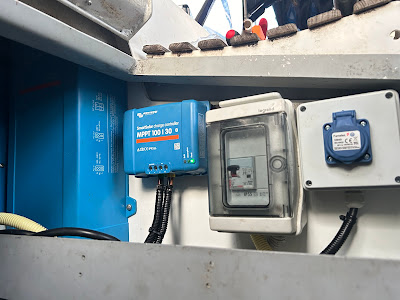I purchased Sakura knowing that her 5 AGM batteries required replacement. Having had a great experience with Windstar's solar and LiFePo battery upgrades, I looked forward to taking this step with Sakura.
Sakura was built in 2001, and since then there have been leaps forward in battery technology, charge sources, combined inverter/chargers, and smart options for monitoring and controlling the entire system. Components are inter-related, and each should be considered as part of a system, which itself should be designed at the outset with clear and realistic use cases in mind. Sakura had some good pieces, but these were a series of add-ons rather than a coherent system upgrade.
The AC infrastrure is discussed here.
Scope
Monitoring and Control
- 1 ea Victron BMV712 battery monitor, (existing) repurposed as a DC current meter for the the solar and hydro generation.
- Victron CERBO GX installed to monitor all systems. New in '24. This provides a single access point for monitoring and controlling power..
- Connectivity can be made via bluetooth, Wifi, Ethernet, and a cabling scheme called VEdirect which uses JST PH series, 2mm pin headers.
- The interface is through direct connection to a touch screen or via an app on a PC or IOS/Andriod device.
- This technology permits GX compatible, components system to be monitored and controlled from a single point, in a consolidated way, most often from the nav station where most other systems converge.
- The entire system can be monitored and configured remotely via the VRM portal.
- smart shunts can be added to provide GX monitoring of non compatible devices but that's not in scope at this point.
- Victron Lynx Shunt - this is a smart shunt that provides data on the batteries and energy usage via the Cerbo GX.
12VDC generation and AC conversion: 5 charge sources, two inverters.
- Existing 2 ea Victron 100W rigid solar panels connected in parallel. via a Victron 30/100 solar controller.
- The solar installation was not producing near its nominal output, as the panels were shaded by the wind generator..
- 1ea Eclectic energy D400 wind generator, now removed.
- 1ea Eclectic energy Sailgen Eclectic energy Sailgen producing approxomately 200w. (was damaged, now repaired.
- victron Multiplus inverter charger - 70 A charging capability. New in 2023.
- 70a alternator with external regulation via a Sterling Power products Advanced Alternator Regulator..
Alternator/DC:DC charger
- Considerations for Alternator use:
- Determine charge profile selected on sterling regulator (AGM setting most likely)
- Can the sterling regulator be connected directly to the liTime batteries or is a dc:dc charger absolutely required?
- Consider disconnecting house bank from sterling alternator for now.
- Document parameters for liTime battery for config.
- Not yet installed is a Victron ORION 30a DC:DC charger. Obviously this device limits alternator charging to 30a. (around 400w) I expect that Victron may bring out a 50A unit before long. It is unclear what how much energy the alternator will produce in real-world operating conditions for an extended period due to heat/thermal protection.
Main (220v) Inverter/Charger
As I explored Sakura I realized that her tiny 350W 220V inverter would not be adequate and that it had been crudely "tacked on" rather than integrated into the electrical system. (probably the intent ws simply to power a laptop or to charge batteries.) Doing a "proper" upgrade meant that her relatively recent 70A Victron Centaur battery charger would be replaced with a much more sophisticated inverter/charger.
In the photos below, taken inside the portside cockpit locker, you can see the Victron automatic isolation transformer (2023) on the far left, the 1600VA Multiplus inverter/charger (2023) beside it, the MPPT controller, shore power breaker, and a 220v receptacle. This was an extremely tight fit in this space. Too tight. If I were to do it again I'd put the isolation transformer on the bulkhead behind the rudder post, and live with the extra wiring.
Batteries - 460ah LiFePo house bank (2024)
- 2ea LiTime 230AH lithium batteries. See here for details of LiTime customer experience. product defect.
- Group 31 AGM start battery.
Start Battery
Battrery isolation - ACR/Diodes
Next steps.
- Install LiFePo batteries. ✅
- Wiring/fusing/distribution to be brought up to standard. ✅
- Master cabin and head euro receptacles to be installed.
- Optimize solar output.
- Ensure all regulation is standardized for LiFePo charge profile voltages.
- Replace Sailgen cable and repair damage to yoke and bracket.
- determine how start/house isolation is achieved (diodes in companionway)
- determine how windlass and winch are installed and fused
- determine how battery switching works and re-label
- Start battery to be relocated to PS cockpit locker for ease of removal and jump starting as required.
- Adaptors to be made for 120V use.
- install DC:DC charger.
- Most of the power related equipment aboard is from Victron, and most is GX-compatible. This means that it can be monitored as part of a system and controlled though a GX device. The CERBO GX is therefore a likely short term upgrade. It is compatible with the Zeus3 MFD as well as the on board ethernet network, and therefore should not require an additional display, though I believe it can display to a generic touch-screen. (USB/hdmi).
DC distribution upgrades
Home made engine battery jump start port?














No comments:
Post a Comment